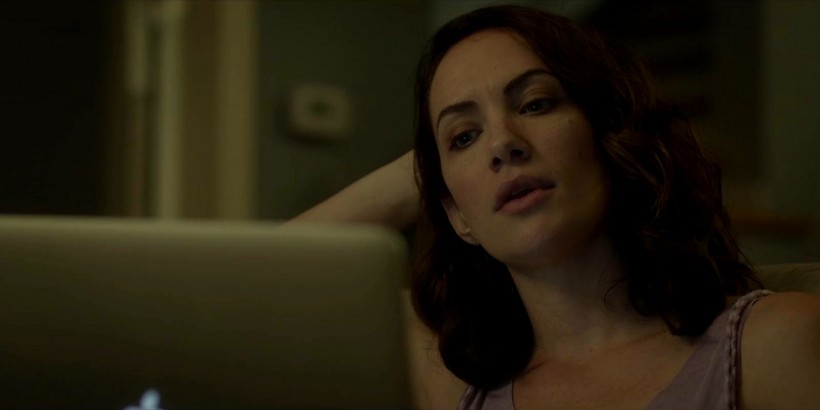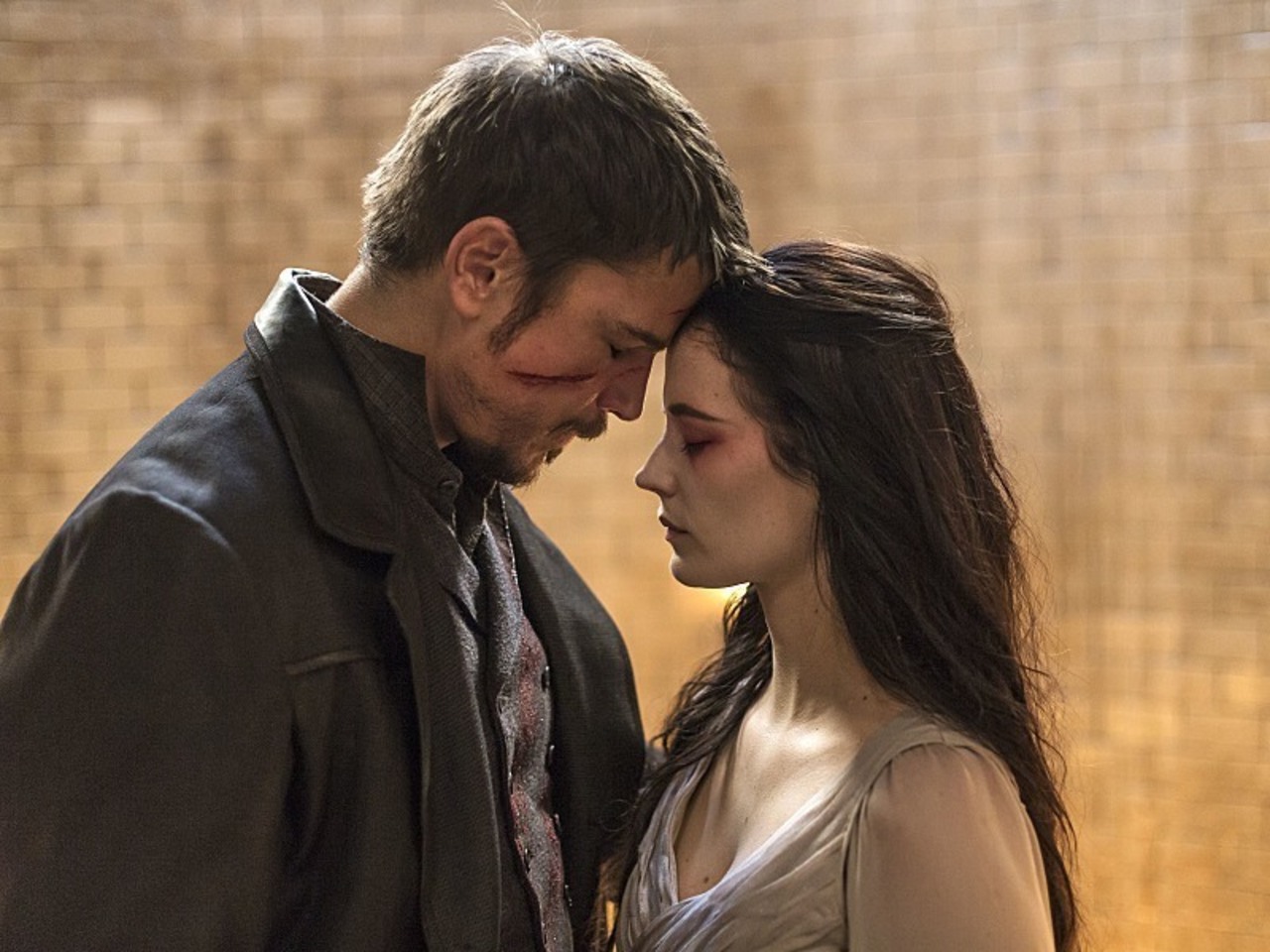This guest post written by Cassandra A. Clarke appears as part of our theme week on Women in Horror. | Spoilers ahead (in the last paragraph).
Horror films thrive on powerlessness, on weaving tales that create vicarious feelings of hope and dread. Many horror movies follow a type of formula: restrict a character’s capability over time as external risks and dangers increase. Films that stick too closely to this pattern become formulaic. Audiences know what to expect, which is usually counterintuitive to manifesting fear, as the very idea that we do not know what is coming or why or how to stop it typically provokes fear. Insert obstacle here: friends travel to rural area and nearby families are out of town sounds like The Strangers or the home invasion sub-genre. Insert physical limitation: protagonist broke their collar-bone and can’t protect themselves which is a common mid-way tactic of horror to increase the plot’s driving sense of inescapability, like in Halloween or the teen slasher sub-genre.
What’s interesting about this formula, however, is its side effect when the same film stars a woman protagonist. Introducing insurmountable obstacles comes at the cost of disempowering its woman lead literally. While horror films in the past five years have started to come to terms with this consequence and spin survivor tales with resourceful, complex female protagonists (The Babadook, It Follows, Raw) it still begs the question: Why are women always the ones having to fight for their safety? Is a survivor’s tale that different than a chase story?
What’s brilliant about Hush, written by Mike Flanagan and Kate Siegel (who stars as the lead), is it pushes the envelope of the survivor’s tale further through its main character, Madison “Maddie” Young: a woman who is deaf, mute, and lives alone in a rural area. In addition to featuring a female protagonist with disabilities, Hush crafts a home-invasion story that isn’t about her “problems” or obstacles or the attacker at all, but rather it focuses on the tactful solutions she chooses along the way. The film challenges the horror genre to be more inventive with escape. Flanagan initially wanted to make a film with the challenge of no dialogue. He and Siegel thought having a deaf and mute protagonist would be “a real benefit to character development.” If this trend of female characters leading their way out of danger is growing, why not see these women as fuller characters who are masters of their own experiences and use their brains as much as brawn to escape?
Flanagan and Siegel use Hush’s opening moments and other scenes of heightened tension to play with sound by turning off the score and diegetic sound and using sound design, such as “audio from ultrasounds,” at certain points for extended time periods in order to acclimate the hearing viewer into Maddie’s world. The film also shows how she adapted to becoming deaf and mute as a child and how she shaped her life as a successful mystery writer. We see a burned dinner that culminates in her strobe-flashing smoke detector going off, Maddie text on her synced Apple devices with her sister who playfully rebukes her for being single, and a conversation with her neighbor Sarah who is learning to sign; we see enough of Maddie’s life to know that she is content and a master of her surroundings. Of course this peaceful life is challenged as Sarah is stabbed violently outside of Maddie’s house while Maddie unknowingly paces around her kitchen, trying to finish a new story she’s writing.
The film cleverly depicts the killer as a faceless man, an interchangeable slasher. He has no name nor back-story. Through this approach, we care less about him as the film cares less about him, opening up room instead to focus on Maddie and her choices. After not seeing Maddie turn around from Sarah’s screams, the man realizes she is deaf and appears aroused by the idea of killing her. Flanagan and Siegel approach his stalking of Maddie in a way that is new and also true to her experiences. Since Maddie cannot hear him, the killer has to find new ways to be known, so he steals Sarah’s phone and sends photos of Maddie to her. As soon as she realizes she’s being watched, Maddie attempts to bargain with the stalker-killer by writing a message backwards in lipstick on the locked glass door that he’s standing in front of, saying that she would never tell anyone that he was here. Her delivery is tongue in cheek. There’s even a flash of what could be called a smirk on Maddie’s lips. The man finds no humor in this; however, the audience can appreciate this moment as this odd display further develops Maddie as a character who even in grim circumstances finds a way to be resilient and playful.
After Sarah’s death, the plot quickly revs up to focus on Maddie’s escape. Hush does not hold back on the gore to accomplish this cat-and-mouse reversal. A crossbow, knives, shattered glass, and a cork-screw are some of the tools used to torture the man and Maddie. Both are injured and both attack, causing the film to feel less like cat and mouse and more like cat and cat, which helps to counteract the fact that it is still, at its core, a film about a woman being hunted. Setting the film in Maddie’s house creates a sense of claustrophobia that mimics not only Maddie’s initial fear but also the growing frustration and rage of her failing assailant.
To its credit, Hush brings Maddie’s career into the story, which she utilizes as a unique resource to help her survive. As a writer, she can look ahead of the story, see the possible outcomes of actions, and weigh the consequences. This decision to make her writing a part of her method to save herself does wonders for the film as it prevents it from relying too heavily on Maddie’s disabilities as a plot device and gives her more things to do, besides run or fight. In between moments of chase and bloody fighting, viewers follow along as Maddie (and the film) literally retreats into her head in imagined scenes, watching her play out possible choices of escape: Should she climb out the window? Does she hide in the bathtub? We see the failures of these fictional choices that lead Maddie to move in another direction. Horror fans can delight in these scenes as the writing becomes a meta-commentary on the formula of home invasion stories — we know this situation well and we know how we would act, and so, Hush invites us to play with choice, and to watch Maddie do the same. She is like us; she knows this story well and so she is desperate to find a better way out, a smarter way out. We’re engaged because we too want Maddie’s story to be different.
While I won’t say Hush soars in its depiction of Maddie as a deaf and mute woman, I think it’s a worthwhile progression to have a disabled character as a fully developed protagonist. Actress-co-writer Siegel is hearing and speaking in real life and I can see some viewers being disheartened that they didn’t cast someone who is deaf or mute. Maddie’s signing doesn’t appear natural or nuanced (using slang gestures, for instance). She might have been more sensitive to seeing motion if this was really happening to her. That being said, I think its depiction of Maddie as a full, engaging character who fends for herself and thrives alone is an asset to adding more characters with disabilities in films, especially horror, as not victims but stars.
I would even go as far to say that the ending suggests this even more. Much like Maddie does in previous scenes, after the final fight, she sits on her porch, closes her eyes, and smiles. Her demeanor is shockingly similar to how she was in imagined moments earlier, not necessarily indicative of someone who just survived a harrowing ordeal. What this suggests to me is that there is a possibility that the ending didn’t happen, that actually, the plot we watched was a story but it wasn’t true in the film’s narrative. Earlier in the film, before Sarah is killed, we see Maddie struggling to write the end to a new thriller. She rewrites the ending multiple times and visualizes how it could go, and is dissatisfied. Sarah’s death ultimately interrupts her and one can imagine that her death, and everything that follows, is of Maddie’s creation. What’s wonderful about this interpretation of the film is that it doesn’t just become a survivor’s tale, it becomes Maddie’s tale and invention and she exists as both the killer and the chased. She is given a duality that has yet to grace horror films that seem to position women as either the kill-or-be-killed model. Hush thrives in knowing what it is and what it is not; it is a tale of the formulas we play with, and it is asking us to play more, to think more.
See also at Bitch Flicks:
How Home Invasion Films Reinforce Gender Stereotypes and Portray Domestic Violence
The Strangers: The Horror of Home Invasion and the Power of the Final Girl
Cassandra A. Clarke is a writer, martial artist, and non-profit professional lady. Her work’s been previously published in Electric Literature, Word Riot, Entropy, other places that love a taste of the weird. In her spare time, she runs the literary magazine Spectator & Spooks. Follow her misadventures @cass__clarke and @spec_ta_tor_mag.







